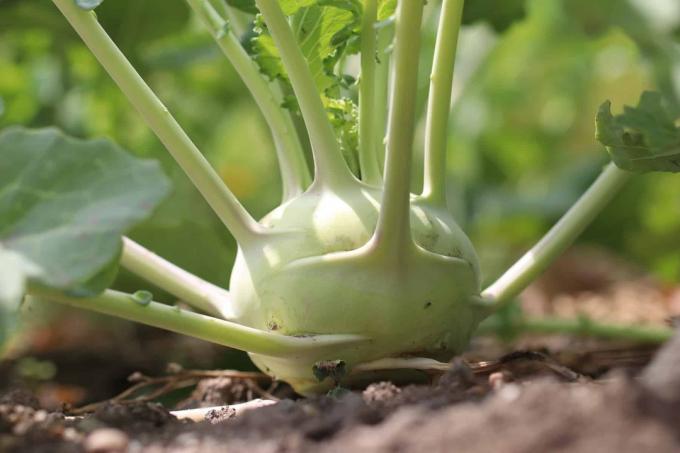
A freshly filled raised bed offers nutrients in abundance. But already in the second year their concentration decreases significantly. The plants must be selected accordingly so that everything thrives. You can find the right planting plan for the raised bed here.
In a nutshell
- in the 1st year the soil is very rich in nutrients; only plant heavy feeders
- in the 2nd Year mainly plant medium feeders
- isolated heavy feeders also possible; no weak consumers
- Fill the bed in autumn, plant in mid-May of the following year
Table of contents
- Nutrient supply in the raised bed
- nutrient requirements of plants
- Examples of heavy feeders
- Examples of middle eaters
- crop rotation
- Planting plan for a vegetable raised bed
- Planting plan for the raised bed on the 1st floor Year
- Planting plan for the raised bed on the 2nd floor Year
- frequently asked Questions
Nutrient supply in the raised bed
The nutrient accumulation in the raised bed due to the decomposition of the filling material is not evenly distributed over the years. Especially in the first year after filling, many nutrients are released, especially the element nitrogen. With each passing year, the nutrient concentration decreases.

nutrient requirements of plants
Plant varieties vary greatly when it comes to how much nutrients they need for healthy growth. With regard to the important nutrient nitrogen, they are divided into three groups:
- heavy feeder: very high nutritional requirements
- Mean Eater: moderate nutritional needs
- weak eater: low nutrient requirements
Examples of heavy feeders
There are heavy consumers among vegetables, herbs and flowers.
Vegetables
- Artichokes (Cynara cardunculus subsp. scolymus)
- Eggplant (Solanum melongena)
- Cauliflower (Brassica oleracea var. botrytis)
- Broccoli (Brassica oleracea var. Italiana)
- Cucumbers (Cucumis sativus)
- Potatoes (Solanum tuberosum)
- Pumpkin (Cucurbita)
- Leek (Allium ampeloprasum)
- Maize (Zea mays)
- Paprika (Capsicum)
- Rhubarb (Rheum)
- Brussels sprouts (Brassica oleracea var. gemmifera)
- Red cabbage (Brassica oleracea var. capitata f. rubra)
- Celery (Apium)
- Sweet potatoes (Ipomoea batatas)
- Tomatoes (Solanum lycopersicum)
- White cabbage (Brassica oleracea convar. capitata var. alpha)
- Savoy cabbage (Brassica oleracea convar. capitata var. sabauda)
- Zucchini (Cucurbita pepo var. Giromontiina)

Tip: When choosing plants, also consider the growth behavior and cultivation period of a variety in order to make optimal use of the limited space in the bed. Pumpkin plants, for example, grow profusely and are more suitable for very large beds.
Flower
- Asters (Aster)
- Chrysanthemums (Chrysanthemum)
- Dahlias (Dahlia)
- Flame Flowers (Phlox)
- Geraniums (Geranium)
- Petunias (Petunia)
- Delphiniums (Delphinium)
- Sunflowers (Helianthus annuus)
- Tulips (Tulipa)

Herbs
- Basil (Ocimum basilicum)
- Fruit Sage (Salvia dorisiana)
- Lovage (Levisticum officinale)

Examples of middle eaters
The list of middle consumers is also long. Among them are mainly vegetables. In the case of the flowers, the heavy feeders are usually highlighted, the other varieties are rarely further subdivided. There are also only a few herbs, since most species are weak consumers.
Vegetables
- Chicory (Cichorium intybus var. foliosum)
- Chinese cabbage (Brassica rapa subsp. pekinensis)
- Endive (Cichorium endivia)
- Fennel (Foeniculum vulgare)
- Kale (Brassica oleracea var. sabellica)
- Carrots (Daucus carota subsp. sativa)
- Kohlrabi (Brassica oleracea var. gongylodes L.)
- Lettuce (Lactuca sativa)
- Swiss chard (Beta vulgaris subsp. vulgaris)
- Parsnip (Pastinaca sativa)
- Radish (Raphanus sativus var. Niger)
- Beetroot (Beta vulgaris subsp. vulgaris)
- Black salsify (Scorzonera hispanica)
- spinach (Spinacia oleracea)
- Pole beans (Phaseolus vulgaris var. vulgaris)

Flower
- Elfspur (Diascia)
- Marigolds (marigolds)

Tip: Even if a raised bed is only to be used for growing vegetables. In between, find a place for the Sudente flower. It repels snails and keeps many other types of pests away.
Herbs
- Borage (Borago officinalis)
- Parsley (Petroselinum crispum)

crop rotation
In order to make optimal use of the changing nutrient supply in the raised bed, you should pay attention to the crop rotation when planting. Only plant heavy feeders in the first year. In the second year you mainly choose medium feeders, occasionally you can also plant some heavy feeders, if necessary. with additional fertilization. Without massive fertilization, in the third year almost only can weak feeder thrive.
Planting plan for a vegetable raised bed
The space available in the raised bed determines how many different plants or how many specimens of a variety can be cultivated. When making your selection, also consider how much a plant can spread over the course of the season. Good neighborhoods also play an important role in such a cramped planting. Below is an example planting plan for a raised vegetable bed.
Planting plan for the raised bed on the 1st floor Year
The following heavy feeders can be grown in the first year:
- cauliflower
- broccoli
- cucumbers
- paprika
- petunias
- delphinium
- celery
- tomatoes
- zucchini

Tip: The cucumber should not be missing here, as it is a very popular vegetable. But it does not get along with other nightshade plants such as tomatoes. Place the cucumber plant best alongside celery.
Planting plan for the raised bed on the 2nd floor Year
The heavy feeder corn, which depending on the variety can also be a medium feeder, is ideal as a climbing aid for pole beans. All plants at a glance:
- dill
- strawberry
- carrots
- Kohlrabi
- lettuce
- Corn
- Beetroot
- spinach
- pole beans
- marigold

frequently asked Questions
Even if heavy feeders need a lot of nutrients, you don't have to fertilize them in the raised bed, or hardly at all. Assuming you have that before planting Properly filled raised bed. The main point of care will be watering, because heavy feeders require a lot of water. Daily watering is a must, especially on warm, hot days.
Melons can also produce ripe fruit in this country when the summer is very sunny and warm. Alternatively, you can attach a greenhouse attachment to the raised bed. Since melons, watermelons and muskmelons are heavy feeders, you should plant them in the first year after filling.
The planting plan should not be implemented until mid-May, as many heavy feeders are sensitive to frost. However, it is possible that Prefer plants at hometo give them a head start in growth.
Fill the raised bed in the fall so that the individual layers can settle by spring. In autumn there is also plenty of filling material such as plant waste and leaves. Warm autumn days promote rotting, so that many nutrients are available for the heavy consumers until spring.



